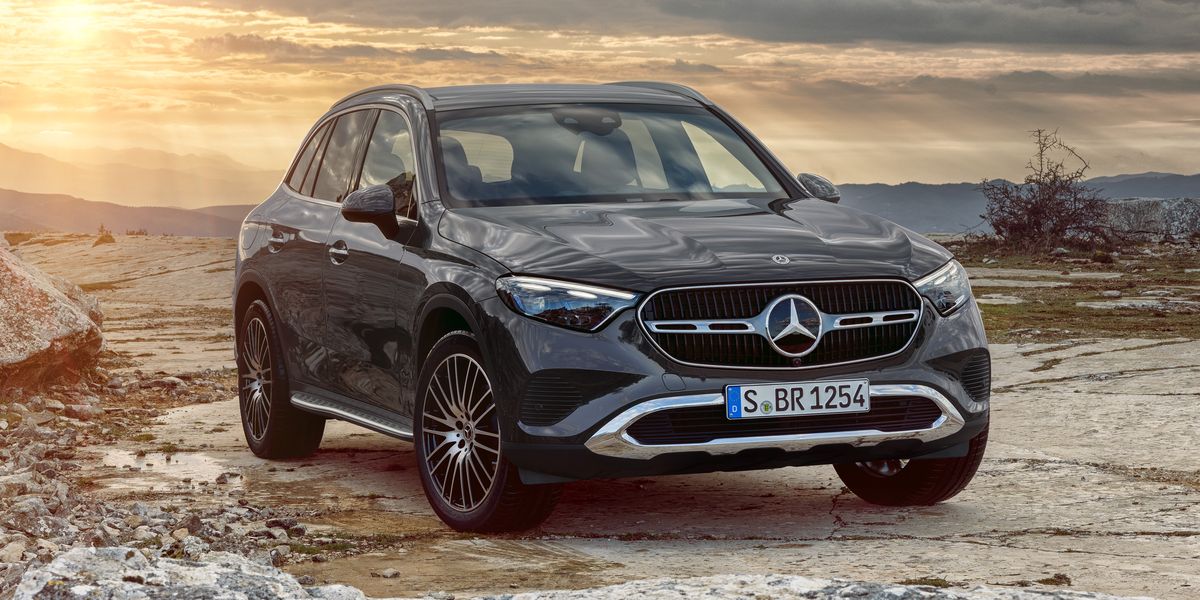2023 Mercedes-Benz GLC Looks Similar but Is New Underneath

Behind similar styling, the new 2023 Mercedes-Benz GLC is bigger than its predecessor.Mercedes says the new MBUX infotainment interface is quicker and smarter.A turbocharged 2.0-liter inline-four with a 48-volt hybrid system will be the only U.S. powertrain option at first.
Where the Mercedes C-class leads, the GLC crossover follows. Given the close relationship between the two cars, which sit on the same platform and share the same powertrain, it’s no surprise that the new GLC that you see here features most of the same technical innovations as its sedan sibling.
Not that we were expecting anything radical. The previous-generation GLC sold well for most of its life thanks to its entirely predictable combination of the typical Benz virtues of handsome design and peppy performance. The styling of the all-new version has evolved so gently that we suspect many will struggle to spot the generational shift; reshaped headlights frame a single horizontal metal strip on the radiator grille, where the outgoing version had two, while the narrower taillights are the giveaway at the back.
Dimensions have expanded slightly. The new GLC is now 185.7 inches long, making it 2.4 inches longer than its predecessor. The wheelbase has also expanded by 0.6 inch to 113.7 inches. Passenger accommodation is barely changed, with Mercedes claiming that rear legroom has increased by 0.1 inch. The most obvious result of the growth is a useful increase in luggage capacity, with the new car’s 22 cubic feet being 3 cubic feet more than the last one.
The new GLC300 that will be offered in the U.S. initially will have a turbocharged 2.0-liter four-cylinder engine working in conjunction with a 48-volt hybrid system through an integrated starter-generator. Similar to the C300 sedan, this engine delivers peaks of 258 horsepower and 295 pound-feet of torque and drives a standard nine-speed automatic gearbox. The only significant driveline choice that buyers of the new car will need to make is whether or not to go for the 4Matic all-wheel-drive system; by Mercedes’s claims, both versions are capable of identical 6.2-second sprints to 60 mph (we ran the previous-generation AWD GLC300 through the benchmark in a more impressive 5.4 seconds). Future versions will likely include both AMG 53 and 63 variants, although both of these will use hybridized four-cylinder engines. Mercedes confirms a plug-in-hybrid powertrain will also be offered in the U.S. eventually.
More substantive changes are found inside the cabin, with the new GLC moving to Mercedes’s new MBUX infotainment system. This uses twin digital displays, an 11.9-inch portrait-oriented central touchscreen (angled slightly toward the driver) and a 12.3-inch digital instrument cluster. MBUX supports high-level voice inputs plus the option of an augmented-reality navigation system that superimposes instructions on a live video feed to show you exactly where to go. We are mildly disappointed, although not surprised, that the GLC will follow the S-class and C-class in ditching both physical HVAC controls for touch-sensitive panels and that it also lacks a physical volume knob.
Other high-tech functions include a Mercedes’s Level 2 Drive Pilot driver-assistance system, standard LED headlights, and a 360-degree camera system that includes what is described as a “transparent hood,” using cameras to deliver a view under the front of the vehicle to help with maneuvering of the sort of mild off-roading a GLC300 might encounter.
There is no word on pricing yet, but we anticipate the new GLC’s increase in standard equipment will be reflected by an increase over the old car. It will begin reaching the U.S. in 2023.
This content is imported from {embed-name}. You may be able to find the same content in another format, or you may be able to find more information, at their web site.
This content is created and maintained by a third party, and imported onto this page to help users provide their email addresses. You may be able to find more information about this and similar content at piano.io



